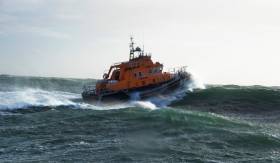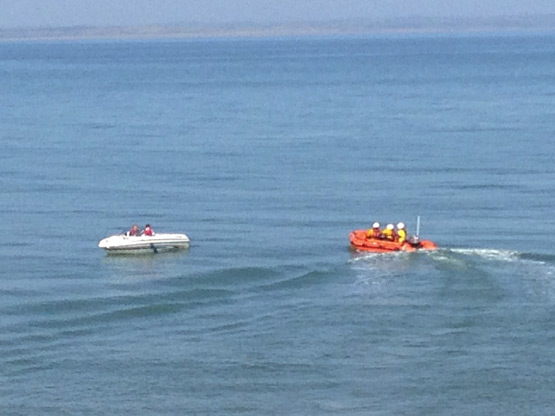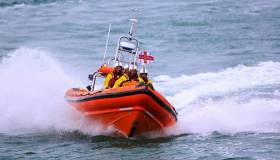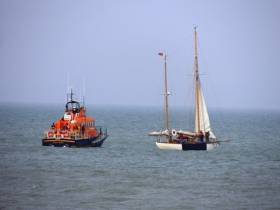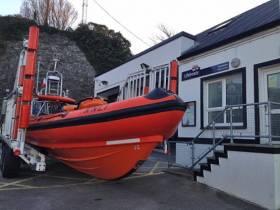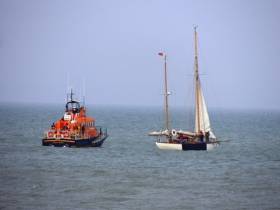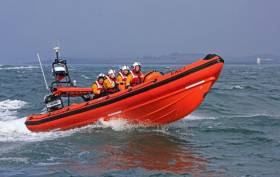Displaying items by tag: RNLI
#RNLI - Rosslare Harbour RNLI volunteers launched their all-weather lifeboat at 7.30am yesterday morning (Sunday 8 May) to answer a call from the Irish Coast Guard to assist a local fishing boat with engine problems.
A very dense fog was down but the skill of the lifeboat navigators and crew ensured a quick location of the vessel, which was a short distance from Rosslare Burrow point off the Wexford coast.
"With a visibility of less than 200 metres, the lifeboat crew did extremely well to locate the vessel so quickly," said Rosslare Harbour RNLI volunteer lifeboat press officer Jamie Ryan.
"This type of weather can come in fast and can be extremely challenging when a vessel suffers engine problems. Thankfully it was a successful callout."
Hours later, Newcastle RNLI launched to assist an adult and child safely back to shore just off Newcastle Harbour in Co Down.
Three volunteer lifeboat crew launched the inshore lifeboat to assist a leisure craft which experienced engine failure. Once on scene, the crew established a tow and proceeded to Newcastle Harbour.
Newcastle RNLI Helm Niall McMurray said: "We’re always happy to help where we can and thankfully conditions were calm with no one injured."
Fethard RNLI Launch to Kitesurfer in Difficulty off Duncannon Fort, Five Months After Similar Callout
In a callout that was virtually identical to one last January, Fethard RNLI was launched this afternoon (Sunday 8 May) to reports of a kitesurfer in difficulty off Duncannon Fort. As with the previous callout the kitesurfer made it ashore safely and was then picked up by the lifeboat’s landrover.
The Fethard lifeboat was launched at 4.20pm when a member of the public raised the alarm after seeing what they thought was a kitesurfer and two windsurfers in trouble near Duncannon Fort. However the two windsurfers were assisting the kitesurfer after he went into the water and was unable to get back up and was struggling. The windsurfers brought him closer to shore but with a strong tide were not able to bring him safely in themselves.
The Fethard lifeboat was en route to Duncannon beach to be launched when the kitesurfer managed to swim to shore himself. He then made his way from the beach inland where he was picked up by the lifeboat landrover. Conditions on the day were calm with good visibility.
Commenting on the callout Fethard RNLI Launching Authority Hugh Burke said, ‘This is the second callout of a similar nature in the last five months and about the sixth in the last three years. The tide in this area is extremely strong and many people are caught out by it, especially when the weather looks fine. The depth of the water shifts quite dramatically and people don’t realise they are on the edge of a major shipping lane. We would urge people to be extremely careful when they are in this area and to take proper safety advice. Thankfully the windsurfers were on hand to give assistance and a vigilant member of the public raised the alarm, however it could have ended very differently.’
Portaferry RNLI Issue Warning on ‘Dangerous’ Craft After Two People have Lucky Escape on Strangford Lough
Portaferry RNLI have issued a strong warning about the dangers of taking to the sea in unsuitable craft after a callout on Friday evening saw two men rescued from the freezing water after the inflatable dinghy they were in became swamped and they ended up in the water. The inflatable craft was fitted with an outboard engine and showed signs of patching on the tube where a repair had been carried out.
Volunteer lifeboat crew with Portaferry RNLI launched at 7.07pm on Friday evening (6 May) to Killyleagh some three and a half miles from the lifeboat station to two men in the water after their cries for help were heard from the shore. On arrival at the scene the lifeboat crew learned that the men, believed to be father and son, had been rescued from the freezing water by a local boat crew.
Commenting on the callout Portaferry RNLI Lifeboat Operations Manager Brian Bailie said, ‘These two men had a lucky escape. If their cries for help had not been heard this could have been an awful tragedy. These types of craft are totally unsuitable for the open waters off our coast. Conditions and tides can change at a moment’s notice and the sea must be respected. An inflatable dinghy which may be okay in a supervised indoor pool is not meant for the sea. Also in this case the addition of the power from the attached outboard engine made an unsuitable craft even more dangerous.’
‘We would urge people to be responsible and check that they are using the proper equipment when they take to the water. Conditions on the lough were quite calm on Friday with a force three and a slight sea, yet these people ended up in serious trouble. Thankfully they were wearing personal flotation devices but they spent some time in freezing cold water before their cries were heard and they were rescued.’
Helvick Memorial To Those Lost At Sea
The annual Mass in remembrance of all those lost at sea, and for their families will be celebrated in Helvick Lifeboat Station on Helvick Pier in Co.Waterford on Friday night of next week, May 13, by RNLI Station Chaplain Fr. Conor Kelly at 7.30pm.
A memorial in memory of those Lifeboat men who have lost their lives in the service of the RNLI saving others at sea on this coastline will be unveiled on Helvick Pier before the Mass begins. Nicholas Hannigan of the Dungarvan and Helvick RNLI Fundraising Branch said: “In 1852 the following brave local men lost their lives: Thomas Crawford, Capt Maurice Duggan, Laurence Lenihan, John Maher, Thomas McNamara, Maurice Mulcahy, Michael Raher and John Whelan. In 1895 Michael Hogan gallantly lost his. It is fitting that heroes from all around the Dungarvan Bay area should be remembered at home too and we hope their descendants can join us for the unveiling! Everybody is welcome to attend.”
When the report appeared here on Afloat.ie on Monday about the assistance given by Arklow RNLI to the “stranded” classic yacht off the Arklow pierheads on May 1st, warning bells rang writes W M Nixon.
For classic boat enthusiasts will have instantly recognised that the yacht in question is the 43ft ketch Maybird, built by Tyrrells of Arklow in 1937, and superbly restored in the heart of the classic yacht industry in Southampton between 2009 and 2011 by a team of all the talents in a job project-managed by owner Darryl Hughes.
Most folk on the classic yacht circuit will be aware that Maybird is entered for the Volvo Round Ireland Race from Wicklow on June 18th, in which she’ll be the oldest boat ever to have taken part. And those of us really in the know will have been aware that Darryl Hughes hopes that members of Arklow Sailing Club - and maybe even descendants of the men who built the boat back in 1937 – will be on the crew for the big race.
The Arklow maritime community being what it is, many members of the sailing club are also on the RNLI Lifeboat Crew panel, and thus some of them were on board Maybird when she set off from Cork Harbour to sail for Arklow early last Saturday as part of a programme to build up mileage experience in order to qualify for the round Ireland.
So when the photo appeared on Monday showing Maybird about to be taken in tow on Sunday evening by the Arklow lifeboat after her engine had failed right in the entrance to Arklow Harbour, at first all we could think of was the embarrassment of those on Maybird at having to be “rescued” by their colleagues.
But then we remembered that May 1st, May Day, is a great lifeboat fund-raising day, and particularly so in Arklow. So then cynical thoughts took over, thinking that maybe this was a cleverly-planned fund-raising stunt: Maybird, Mayday, May*rs* we thought.
There are times you can be just too hard-bitten. Turns out the whole story is absolutely kosher. Prior to leaving winter quarters in Crosshaven, when servicing the engine Darryl had noticed the bleed screw on the secondary fuel filter did not seem to be making an airtight fit. But the engine started with no bother, and motored the boat without trouble from Crosshaven to the Custom House Quay in Cork to meet the Arklow crew, and then took Maybird, with full complement aboard, down to Cobh on Friday evening to prepare for departure towards Arklow last Saturday morning.
They’d a fine sail round to the east coast, going outside the Tuskar to simulate round Ireland conditions, but then off the Glassgorman Bank an engine start test failed. There was air in the fuel system, but Darryl solved the problem with plumbers’ PTFE tape on the bleed screw, and they were back in business with a fading breeze, motoring the final miles and stowing sails with the engine performing well.
But just as the pierheads came abeam, the engine cut out. Fortunately Maybird’s multiple-sail rig provides almost instant hoisting of the staysail – “always the last sail to be stowed” – and they were able to sail clear and keep the situation under control while the Arklow lifeboat leapt at the chance to carry out a rescue.
As it happens, Jimmy Mylor, who organises the Arklow Sea Scouts in addition to being on the Lifeboat Crew, had meant to be on Maybird, but work commitments had caused him to drop out. Yet it was he who handed Maybird’s crew the lifeboat’s towing warp amidst much banter, banter which went on for some time.
But now the Arklow marine industry have rallied round to make sure that a new bleed screw on Maybird’s secondary filter is getting a proper seal, and all being well, Maybird will race this Saturday in Arklow SC’s weekend event. We don’t know how much extra RNLI fund-raising was done as a result of this “stunt-for-real”. But the message yet again is that you can only have three problems with a good modern marine diesel engine – fuel, fuel, and fuel.

Maybird as she looks when all is as it should be
Dunmore East RNLI Raises Vital Mayday Funds
#RNLI - Vital funds have been raised for the RNLI following the annual Dunmore East lifeboat 'Dash & Splash' and yellow welly throwing competition.
The event, which took place at Councillor’s Strand in Dunmore East on Sunday 1 May, was run as part of Mayday, the RNLI’s national annual fundraising campaign.
Dunmore East RNLI fundraising branch volunteer Carol McGeary said: "I’d like to thank everyone who came and supported the Dash & Splash and yellow welly throwing competition.
"We were especially delighted to have Senator Grace O’ Sullivan taking part and leading the swimmers into the water.
"We all had great fun with the welly throwing competition and the crew even challenged our supporters to a beach soccer match. The funds raised will help the RNLI continue to save lives at sea’.
McGeary added that RNLI volunteers in Dunmore East and around Ireland "are willing to drop everything to go and save lives at sea when their pagers beep.
"Mayday is the RNLI’s own call for help, as we rely on the generosity of the public to continue our lifesaving service, which we operate day and night, 365 days a year."
Many of the Mayday fundraising events that have taken place across the country have had a yellow welly theme, in a nod to the essential kit that the RNLI’s lifeboat crew members wear on their feet when they go out to sea to save lives.
Money raised through the Mayday campaign – which ran from Tuesday 26 April to Monday 2 May – will support the RNLI’s lifesaving work. It could be used to fund crew training, contribute towards the running costs of a lifeboat station or buy new crew kit like the yellow wellies.
There is still time to support Mayday. Visit RNLI.org/Mayday to donate.
The RNLI operates 45 lifeboat stations around Ireland. Last year, RNLI lifeboat crews in Ireland launched 1,098 times bringing 1,244 people to safety.
Bundoran RNLI Soapbox Race Returns For Fifth Year
#RNLI - The eagerly anticipated Bundoran RNLI Soapbox Race makes its return to Bundoran’s Astoria Road on Bank Holiday Sunday 5 June.
Following last year’s cancellation of the event due to unfavourable weather conditions, the volunteer lifeboat crew are this year determined to make the fundraising event even better than ever.
The current holders of the title of soapbox champions are Bundoran’s Ward Automation and they are anxious to retain their title.
Spectators can expect the usual excitement that they have grown to expect since the event began back in 2012 with participants encouraged to begin the build of their soapbox so that it is ready on time.
The €1,000 ball race will also make a welcome return on the day with balls being sold for €5.
Each ball is numbered and then released down the hill. The first ball through the funnel at the end will win the €1,000 which has been donated by local businesses. Balls will be on sale on the day.
The event will kick off at midday with a skate competition as local longboarders display their skills in advance of the soapbox race. The soapbox race will follow with the day coming to a close with the ball race.
Bundoran RNLI event co-ordinator Cormac McGurren is encouraging all budding soapboxers to start building.
"The countdown is on and we want to see as many soapboxes taking part as is possible," he says. "We would love to see all the local businesses involved and competing against each other to have plenty of friendly rivalry on the day.
"We would also encourage locals and visitors alike to come along and enjoy a good day out. All proceeds raised will go to helping our volunteers in Bundoran to continue to save lives at sea."
All the details of the day, including registration forms, can be found online at www.bundoranlifeboatsoapboxrace.com
Arklow & Bangor Lifeboats Have Busy May Day Weekend
#RNLI - Lifeboats from Arklow and Bangor were out on the water for separate callouts on May Day yesterday in what made for a busy weekend for the RNLI crews.
In Arklow, RNLI lifeboat volunteers were alerted by pager around 7pm on a fine Sunday evening (1 May) to a call for help from a vintage sailing vessel.
The lifeboat Ger Tigchleaar was launched within minutes to the classic boat, which has suffered engine failure and was stranded just east of Arklow Harbour.
The Arklow RNLI volunteer crew established a tow line and proceeded to tow the vessel safely back into Arklow. The five experienced crew members on the casualty vessel remained aboard during the tow home and all hands came ashore safely at Arklow.
Speaking after the incident, volunteer lifeboat press officer and community safety officer Mark Corcoran said: "On this, the RNLI’s Mayday fundraising weekend, our fundraising team and boats crew have been busy with all kinds of fundraising events.
"Even after a long day of fundraising our dedicated volunteers turned up this evening en masse to go to the aid of the crew of this stricken vessel.
"We’re all very proud to be involved with the RNLI, so please give generously to the Mayday campaign to help keep us doing what we do, which is saving lives at sea."
Elsewhere on the same evening, Bangor RNLI’s volunteer lifeboat crew launched to the aid of a RIB with engine failure just off Royal North Yacht Club in Belfast Lough.
Although not in immediate danger, a strong breeze was blowing the vessel, with one person on board, offshore. Thankfully the Bangor inshore lifeboat was able to tow the RIB in to Royal North without incident.
Bangor RNLI volunteer helmsman Gareth Whan said: “The crew and I are delighted to have been able to return this vessel safely to shore. Engine failure can happen in the best-maintained boat, and we are pleased to have been able to help.”
This was Bangor RNLI’s second callout of the weekend. On Friday evening (29 April) they were asked by Belfast Coastguard to assist Lagan Search and Rescue and other emergency services in a detailed search of Belfast Harbour for a person in the water.
Sadly, this callout did not have a happy ending. The search was called off after three hours, and resumed on Saturday morning. However, it was only yesterday (Sunday 1 May) when a body was found by police divers.
Bangor RNLI extended its sympathies to the family of the man and all involved in the attempted rescue.
“It is sadly appropriate that both of these launches happened during the May Day weekend, a key fundraising time for the RNLI, and highlight the importance of the work our volunteers do,” said Bangor's deputy launching authority Bryan Lawther.
#RNLI - The volunteer lifeboat crew at Portaferry RNLI responded to a launch request from the coastguard yesterday morning (Saturday 30 April 2016) to assist two men on board a yacht stranded on rocks in Strangford Lough, Co Down.
Portaferry's inshore Atlantic 85 launched at 9.22am and the volunteer crew were quickly on scene at Long Rock, just off East Down Yacht Club, 10 minutes later.
Weather conditions at the time was cloudy with good visibility, a Force 3 north westerly wind and calm sea.
When the RNLI crew arrived, they fixed a line to the 28ft yacht and towed it off the rocks.
Once their yacht was free, the two men on board proceeded to East Down Yacht Club accompanied by the Portaferry lifeboat crew, who remained with the yacht until it was safely returned to the pontoons at the yacht club.
After the callout, Portaferry RNLI lifeboat operations manager Brian Bailie said: "It has been a busy few months for the crew in Portaferry and we were delighted to have been able to assist these two men who had run into some difficulty.
"We are now entering our most busy time of year and we would urge everyone taking to the water to make sure that they prepare properly and check that all equipment is tested and in good working order."
The RNLI offers sea safety advice online at RNLI.org/RespectTheWater
Answer the RNLI’s Mayday Call & Help Save Lives at Sea
People across Ireland are being encouraged to help raise vital funds for the RNLI as part of the charity’s national annual fundraising event, Mayday.
The RNLI’s Mayday campaign runs through to the May Day bank holiday next Monday 2 May, with street collections and fundraising events taking place across the country.
RNLI lifeboat crew members are volunteers and remain on call 24 hours a day, and when the pager goes off they’ll drop everything to help somebody in need - often sacrificing their work and personal commitments.
David Howard, volunteer crew member at Howth lifeboat station, knows only too well the sacrifices that RNLI volunteers need to be willing to make, in order to drop everything and save lives at sea.
After months of secret preparation, David was all set to finally pop the question on Christmas Eve night. He had the specially designed ring in his hand and he was just waiting for his girlfriend to come home so he could get down on one knee and ask her to marry him – but then his pager beeped.
Abandoning his plans, David dashed to the lifeboat station. One minute he was plucking up the courage to propose, the next minute he was in the lifeboat out at sea saving a fisherman with head injuries.
On Christmas morning, David was finally able to get down on one knee and ask his girlfriend to marry him. And, of course, she said yes!
David said: ‘When the pager beeped, I didn’t think twice before dashing straight to the lifeboat station. Like all of the RNLI’s volunteer crew members, I know that when the pager beeps, every second counts, so you have to stop whatever you’re doing to go and save lives at sea.
‘The way I was going to propose was carefully planned to the finest detail, but all of those plans went out of the window when the pager went off. Luckily, I was able to pop the question the next day, and I was over the moon when she said yes.’
Every day is Mayday for the RNLI’s lifeboat crews, who are specially-trained volunteers, on-call 24/7 to save lives at sea. Whatever the weather, day or night, they are ready to drop everything and launch the lifeboats to rescue anyone in danger at sea. But, as a charity, the lifesaving service they provide is only possible thanks to the generous support of the public.
Many of the Mayday fundraising events have a yellow welly theme, in a nod to the essential kit that the RNLI’s lifeboat crew members wear on their feet when they go out to sea to save lives.
The charity is encouraging people to show their support by using the hashtag #MaydayEveryday on social media, buying and wearing a Mayday yellow welly pin badge, hosting or supporting a fundraising event or donating online.
Money raised through Mayday fundraising events will support the RNLI’s lifesaving work – it could be used to fund crew training, buy new crew kit, or contribute towards the running costs of a lifeboat station.
Visit RNLI.org/Mayday to donate, to order a pin badge or to see what other ways you can support the RNLI’s Mayday campaign.
The RNLI operates 45 lifeboat stations around Ireland. Last year, RNLI lifeboat crews in Ireland launched 1,098 times bringing 1,244 people to safety.




























